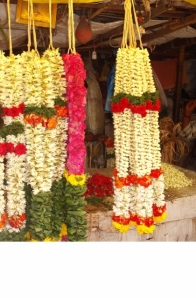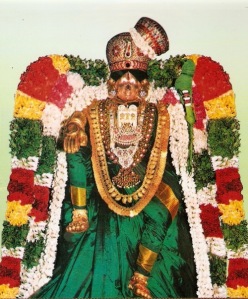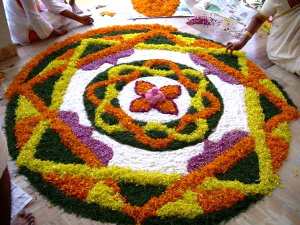
Tamils are crazy about flowers. Travellers have noticed the passion of Tamil women for flowers. Every temple and every bazaar(shopping area) has scores of flower vendors who make garlands and flower strings with fresh flowers. Half of the flowers go on the hair of women and the other half go to the Gods inside the temples. Half of the garlands go into the neck of Tamil politicians and the other half go in to the neck of gods’ statues.
This love for flowers is not a new fashion. The love story began at least two thousand years ago. We have several references of flower vendors in the Sangam Tamil literature (Narrinai verse 97,118,160 etc.)
Tamil’s custom of wearing lot of flowers on their heads was noticed by Valmiki in his Ramyana:Bharata says our soldiers are wearing lot of flowers on their heads like southerners and carry black coloured shields (ayodhya Kanda, Sarga 96)
Tamils are unique in one thing. The three powerful kingdoms of Tamil Nadu had separate flags, emblems and flowers. Like we choose a national flower of a county they chose one flower garland each. The Sangam works simply mention the particular flower garland to mention the king.In other words, the garlands were more popular than the dynasty name! Pandya kings wore Neem flower garlands, Chera Palmyra flower garlands and the Cholas Athi (fig) flower garlands.
Tamils divided their lands into five natural geographical areas add gave the name of dominant flowering tree/plant to each area. At least this custom has precedence in other parts of India. Sanskrit literature called India Jambu dwipa meaning land of Jamboo trees (Rose apple tree). It also divided the globe into seven different continents and named them after the predominant flowering tree of that area: Jambu (Rose apple),Plaksha (fig tree), Shalmali (Silk Cotton Tree), Kusha (Darba grass), Krauncha (water birds, may be some trees with the same name) Shaka and Pushkara (Lotus)
Five regions of Tamil Land
Mullai , a variety of Jasmine, stands for the forest area.
Kurinji, a mountain flower, stands for mountainous region.
Marutham, a tree with red flowers, stands for patoral region
Neytal, a water flower, stands for sandy sea shore
Palai, an ever green tree growing in arid areas, stands for arid lands.
Another unique feature of Tamil culture is they wore different flowers in the battlefield to denote different activities. No other culture wore flowers when they went to war. We know that Olympic winners in Greece received Olive branches. But Tamils took different flowers. For instance if they want to invade a country, soldiers will go in to the border areas and steal the cattle wearing VETCHI flowers. Though this practice of stealing cattle was in Mahabharata days in the north of the country, the soldiers did not wear any particular flower. But Tamils wear a particular type of flowers during this raid which is not found anywhere in the world. For each and every military activity they allocated a flower. Following is the list of flowers and the corresponding activity:
§ Vetchi - the provocation of war through attack and cattle raids
§ Karanthai - defending against cattle raids
§ Vanchi - invasion of the enemy's territory
§ Kanchi - transcience and change, the fragility of human life, against the backdrop of war
§ Uzhingai- attacking the fort
§ Nochchi - defence of the fort or territory
§ Thumpai - the frenzy of battle
§ Vaakai - victory
§ Paadaan - praise of a king's heroism or generosity, asking for gifts
But this was not strictly followed. Tamil men and women wore flowers. Men had flowers in their ears. Women had it on their heads. Women continue to wear it even today. During weddings they spend a lot on flowers.
Pushpanchali (Flower Offering)
In Bhagavad Gita Krishna also spoke about offering flowers and leaves (Tulsi, Bilva) to God. Tamil poet Kapila has translated that sloka in Purananuru
Pushpanchali is an annual event in several South Indian temples. They heap hills of flowers on God on that day.
ANDAL MALAI/ GARLAND

Tamil Nadu is famous for its biggest flower garland called Andal Malai (Malai=Mala+ garland). This garland is a special one meant for Andal of Srivilliputtur, near Madurai. Andal, who lived 1300 years ago in Srivilliputur of Tamil Nadu, was a Vishnu devotee. This garland is normally 8 ft long made up of different flowers. It is heavy and expensive. Political heavy weights get this heavy garland, particularly after election victory.
Kapilar’s Guinnes Record-99 flowers
Sangam Tamil poet who lived 200 years ago would have entered Guinnes Book, has there been a category for reciting flower names. He recounted 99 flowers in his Kurinjipattu ( Lines 62-97). Though other books like Mahabharata, Valmiki Ramayana, Kalidasa have provided more flower names, no one poet had given them at one go.
“Tamil Nadu Assembly Speaker, K. Kalimuthu, who spoke on `Tamil and Tamilians in world arena,' kept the audience spellbound for about 30 minutes. The audience was stunned when he repeated the names of 99 flowers from Kabilan's Kurinji Pattu. All the students of Jamal Mohamed College (Trichy)who had occupied every inch of the auditorium maintained pin drop silence and heard his speech in rapt attention.” (The Hindu report on August 16, 2004).
Of the 99 flowers many of them have Sanskrit names and a few of them are unidentifiable.
Onam and Pukkolam
Onam is an old festival mentioned in Tamil Sangam literature (maduraikanji 590-591). Till this day it is celebrated in Kerala (Old Tamil Chera country) with gigantic flower decorations on the ground called Pukkolam.

Tamil classification
Even before Linnaeus classified the botanical kingdom, Tamils classified them in to four categories: Kottu Pu, Kodi Pu, Neer Pu, Nila Pu.
Kottu Pu=Kongu, Shenbakam Makiz etc.
Kodi Pu= Mallikai, Mullai (jasmine varieties) etc.
Neer Pu (water flowers)= Lotus, Water Lily etc.
Nila Pu ( Land flowers)= Thumbai, Sevanthi etc.
They talk about flowering plants and non flowering plants, flowers to give good fragrance to water (Pathiri Pu) etc.
21 leaves for Vinayaka
Ancient Tamils even knew all the plant names by heart. They allocated 21 leaves for Ganesh Puja. Such acts serve many purposes: 1. Spread of knowledge about plants 2.Herbs are used when someone falls sick 3. Naturala environment is protected. Following are the 21 plants: Masi pathram, Bruhati pathram,Bilva pathram, Durva pathram, Thuthura pathram, Badari pathram,Apamarga pathram, Tulsi pathram, Suta pathram, Kraveera pathram, Vishnugranthi pathram, Thadi pathram, Deva thaaru pathram, Maruva pathram, Sindhuvara pathram, Jaji pathram, Kandaki pathram, Samee pathram, Asva pathram, Arjuna pathram, Arka pathram.
By London Swaminathan ([email protected] or [email protected])
